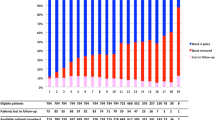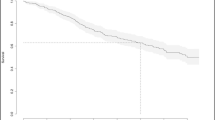Abstract
Background
Laparoscopic adjustable gastric banding (LAGB) is a commonly performed bariatric procedure. LAGB is frequently complicated by slippage. Possible treatment for slippage is rebanding, but long-term effects are unknown. The aim of this study was to investigate whether rebanding after gastric band slippage is associated with weight loss failure.
Methods
This was a post hoc analysis of a prospectively collected database of 627 consecutive LAGB patients. Rebanding for slippage was performed in 81 patients. The effect of rebanding on weight loss was evaluated by three analyses: (1) in 81 rebanded patients, weight loss was compared before and after rebanding, separately for patients in whom primary LAGB was successful or unsuccessful; (2) 81 rebanded patients were matched to 81 patients without slippage for prognostic variables and compared for weight loss after rebanding; (3) multivariate logistic regression was performed whether rebanding was independently associated with weight loss failure.
Results
The chance of a fair result of rebanding for patients following primary successful (n = 34) and unsuccessful LAGB (n = 22) was 62 and 27 % after median follow-up of 113 and 97 months, respectively. There was no difference in weight loss failure between 81 rebanded patients and 81 matched patients: 54 vs 59 % (P = 0.43). In multivariate analysis, rebanding was not significantly associated with weight loss failure: adjusted odds ratio 1.42; 95 % confidence interval 0.85–2.38; P = 0.18.
Conclusion
In general, rebanding after LAGB has no negative effect on weight loss. However, patients in whom LAGB was unsuccessful prior to rebanding have poor long-term weight loss results.



Similar content being viewed by others
References
Mattar SG. Lifting the unbearable weight of morbid obesity. Ann Surg. 2008;247:28–9.
Allison DB, Fontaine KR, Manson JE, et al. Annual deaths attributable to obesity in the United States. JAMA. 1999;282(16):1530–8.
Fontaine KR, Redden DT, Wang C, et al. Years of life lost due to obesity. JAMA. 2003;289(2):187–93.
Pontiroli AE, Morabito A. Long-term prevention of mortality in morbid obesity through bariatric surgery. a systematic review and meta-analysis of trials performed with gastric banding and gastric bypass. Ann Surg. 2011;253(3):484–7.
Perry CD, Hutter MM, Smith DB, et al. Survival and changes in comorbidities after bariatric surgery. Ann Surg. 2008;247(1):21–7.
Sjöström L, Narbro K, Sjöström CD, et al. Effects of bariatric surgery on mortality in Swedish obese subjects. N Engl J Med. 2007;357(8):741–52.
Buchwald H, Oien DM. Metabolic/bariatric surgery worldwide 2008. Obes Surg. 2009;19(12):1605–11.
Nguyen NT, Slone JA, Nguyen XM, et al. A prospective randomized trial of laparoscopic gastric bypass versus laparoscopic adjustable gastric banding for the treatment of morbid obesity: outcomes, quality of life, and costs. Ann Surg. 2009;250(4):631–41.
O’Brien PE, Dixon JB, Laurie C, et al. A prospective randomized trial of placement of the laparoscopic adjustable gastric band: comparison of the perigastric and pars flaccida pathways. Obes Surg. 2005;15(6):820–6.
NIH conference. Gastrointestinal surgery for severe obesity. Consensus Development Conference Panel. Ann Intern Med. 1991;115(12):956–61.
Belachew M, Legrand M, Vincenti VV, et al. Laparoscopic placement of adjustable silicone gastric band in the treatment of morbid obesity: how to do it. Obes Surg. 1995;5(1):66–70.
Robinett-Weiss N, Hixson ML, Keir B, et al. The metropolitan height–weight tables: perspectives for use. J Am Diet Assoc. 1984;84(12):1480–1.
Schouten R, Japink D, Meesters B, et al. Systematic literature review of reoperations after gastric banding: is a stepwise approach justified? Surg Obes Relat Dis. 2011;7:99–109.
Gagner M, Gumbs AA. Gastric banding: conversion to sleeve, bypass, or DS. Surg Endosc. 2007;21(11):1931–5.
Egan RJ, Monkhouse SJ, Meredith HE, et al. The reporting of gastric band slip and related complications; a review of the literature. Obes Surg. 2011;21(8):1280–8.
Singhal R, Bryant C, Kitchen M, et al. Band slippage and erosion after laparoscopic gastric banding: a meta-analysis. Surg Endosc. 2010;24(12):2980–6.
Iannelli A, Gugenheim J. Laparoscopic Roux-en-Y gastric bypass, but not rebanding, should be proposed as a rescue procedure for patients with failed laparoscopic gastric banding. Ann Surg. 2005;241(2):383–4.
de Wit LT, Mathus-Vliegen L, Hey C, et al. Open versus laparoscopic adjustable silicone gastric banding: a prospective randomized trial for treatment of morbid obesity. Ann Surg. 1999;230(6):800–5.
Van de Laar A, de Caluwe L, Dillemans B. Relative outcome measures for bariatric surgery. Evidence against excess weight loss and excess body mass index loss from a series of laparoscopic Roux-en-Y gastric bypass patients. Obes Surg. 2011;21(6):763–7.
Conflict of Interest
The authors declare that they have no conflicts of interest.
Author information
Authors and Affiliations
Corresponding author
Rights and permissions
About this article
Cite this article
te Riele, W.W., van Santvoort, H.C., Boerma, D. et al. Rebanding for Slippage After Gastric Banding: Should We Do It?. OBES SURG 24, 588–593 (2014). https://doi.org/10.1007/s11695-013-1119-4
Published:
Issue Date:
DOI: https://doi.org/10.1007/s11695-013-1119-4




